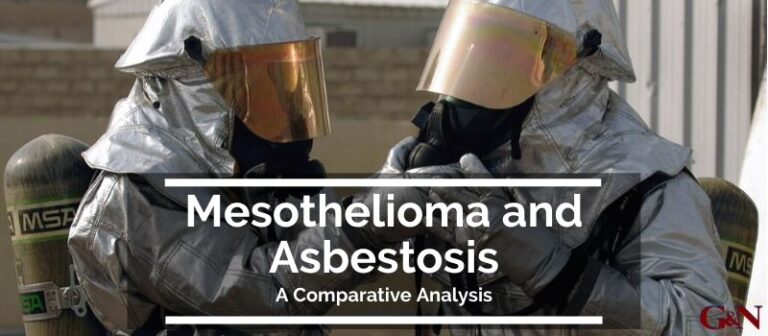What Is Asbestosis?
Asbestosis is the scarring of lung tissue due to prolonged exposure to high levels of asbestos dust. Asbestosis symptoms can develop after 10-20 years of breathing this dust.
Symptoms and Diagnosis of Asbestosis
Asbestosis symptoms include:
- Chest pain and tightness
- Shortness of breath or respiratory crackling
- Clubbing or misshaped nails, toes or fingers
- Discoloration of the skin due to lack of enough oxygen
- Heart problems
Treatment for Asbestosis
Asbestosis has no cure. However, treatment aims to relieve the symptoms and slow the disease progression. Some of the treatment options include:
- Use of inhalers and breathing tanks
- Antibiotics and pain medicine
- Oxygen therapy to drain lung fluid
What Is Mesothelioma?
Mesothelioma is cancer of the membranes located at the lungs, chest cavity wall linings, and the abdomen. These membranes are known as pleura.
Just like asbestosis, mesothelioma is caused by inhaling asbestos dust. However, mesothelioma can result from inhaling low levels of asbestos dust over a long period.
Symptoms and Diagnosis of Mesothelioma
It takes around 30-40 years after exposure for mesothelioma symptoms to appear. The symptoms include:
- Pain while coughing or swelling of the abdomen
- Chest pain under the patient’s rib cage
- Weight loss
- Tissue lumps that you can feel under your chest or abdominal skin
Mesothelioma Treatment
There is no cure for mesothelioma. However, common cancer treatments such as surgery, chemotherapy, radiation therapy, and targeted therapy can help remove the cancerous cells.
Prognosis of Asbestosis and Mesothelioma
Mesothelioma patients get a prognosis of 4-12 months. Asbestosis prognosis is much better, as some patients have lived for decades with the disease. However, most asbestosis patients have a decreased quality of their life as the disease progresses.
What happens if you breathe asbestos?
A one-time inhaling of asbestos will not cause you any serious risk unless there is extreme toxic asbestos dust in the air. However, if you breathe asbestos for years or months, you may be at a higher risk of suffering from asbestos-related diseases.
What does asbestos do?
Asbestos is a natural mineral that is soft, flexible, and resistant to corrosion, electricity and heat fibers. When someone inhales the asbestos dust, the fibers remain trapped in the person’s body. Ingestion of asbestos can also cause asbestos poisoning. The trapped fibers can cause scarring, inflammation and genetic damage to the patient’s body cells over a prolonged period. The result is asbestos-related diseases such as asbestosis, lung cancer, or mesothelioma.
If you have been exposed to asbestos at the workplace or suspect that the symptoms you are having may be from an asbestos-related disease, you can get help from a workers’ compensation lawyer. You also need to contact your doctor immediately to get an accurate diagnosis of your medical issue.











